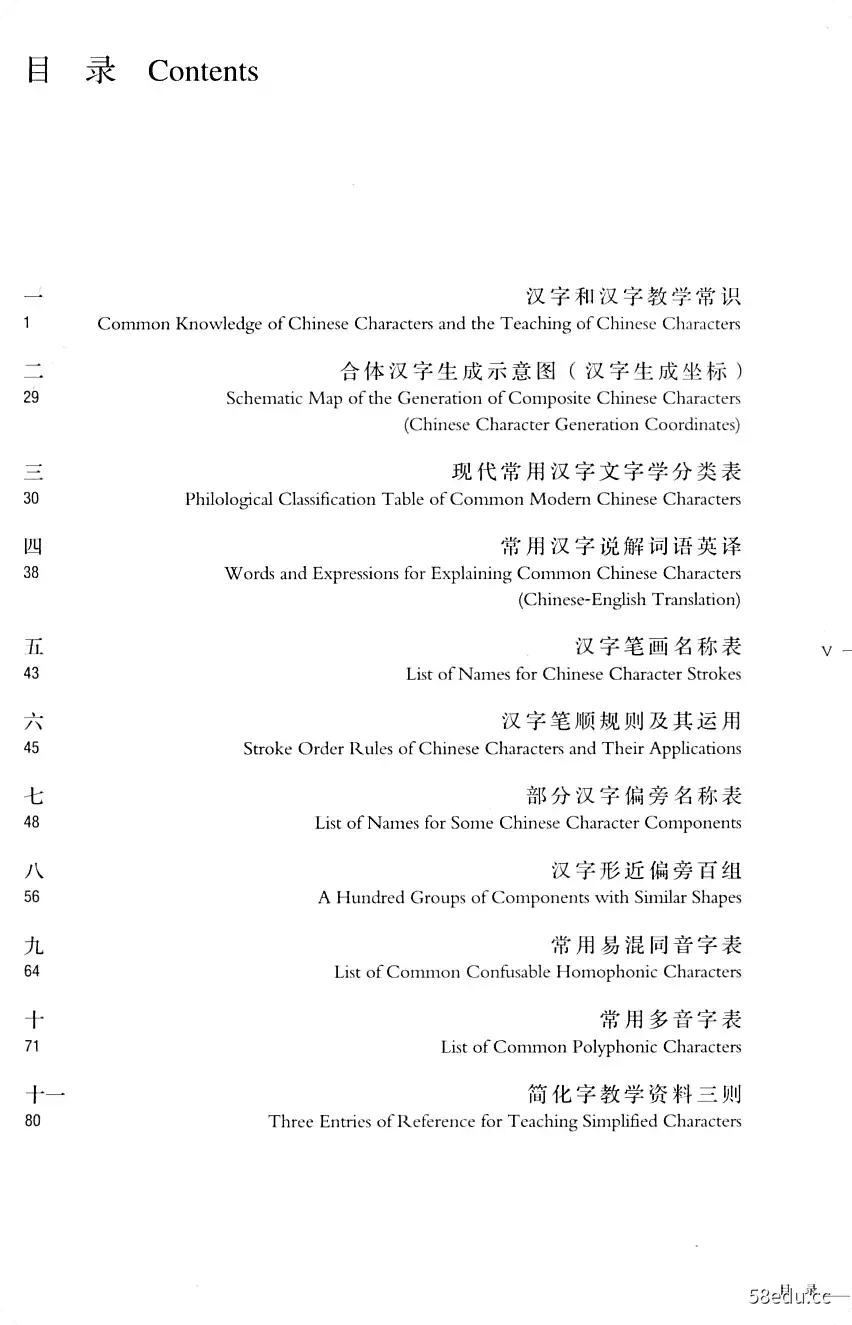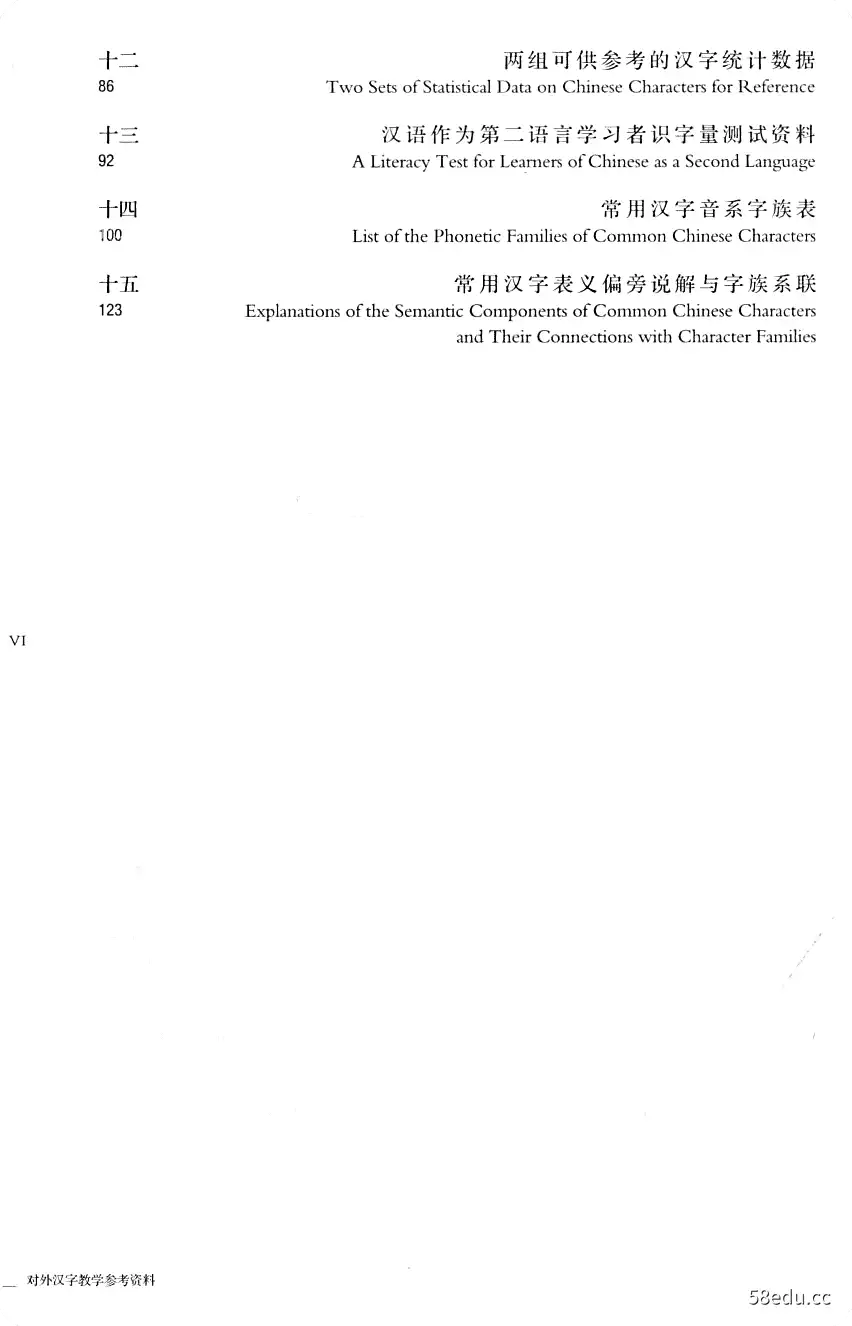《对外汉字教学参考资料》李大遂编著|(epub+azw3+mobi+pdf)电子书下载
图书名称:《对外汉字教学参考资料》
- 【作 者】李大遂编著
- 【页 数】 224
- 【出版社】 北京:北京语言大学出版社 , 2020.06
- 【ISBN号】978-7-5619-5609-0
- 【价 格】65.00
- 【分 类】汉字-对外汉语教学-教学研究
- 【参考文献】 李大遂编著. 对外汉字教学参考资料. 北京:北京语言大学出版社, 2020.06.
图书封面:
图书目录:


《对外汉字教学参考资料》内容提要:
本选题是一本对外汉字教学参考资料。内容涵盖了对外汉字教学所需参考的各种资料,如依托HSK《汉字等级大纲》和《现代汉语常用字表》的文字学分类表,汉字笔画名称表、笔顺规则及运用表、偏旁名称表,常用形近字表、同音字表、多音字表,各级留学生识字量考核标准及分班测试依据资料,汉字知识百则及常用汉字音系、义系字族表等。无论是初级班,还是中级班、高级班,只要开设汉字教学课或选修课,本选题定有可供其教学需要参考的内容。
《对外汉字教学参考资料》内容试读
汉字和汉字教学常识
Common Knowledge of Chinese Charactersand the Teaching of Chinese Characters
题解:
汉字是汉语的书写符号系统。要学习汉语,特别是要获得汉语读写能力,必须学习汉字。要学好汉语,必须尽可能多地掌握汉字。对于许多母语非汉语的外国学生来说,汉字是神秘的,是他们学习汉语最大的难点。对于对外汉语教师来说,教汉语就得教汉字。要教学汉语的外国学生顺利入门,就要破除他们的汉字神秘感,打消他们的汉字畏难情绪,带领他们逐步走进汉字的理性世界。这里最好的办法是让学生了解有关汉字的常识,比如汉字的历史、造字方法、理据、结构(特别是内部结构)、读音和意义的系统性等。本资料介绍汉字和汉字教学的基本常识,希望能为教学双方把握汉字和汉字教学的特点、规律提供帮助,从而科学高效地推展汉字教学。
本资料选自李大遂《汉字联想字典·附录》(商务印书馆即将出版),原题为《汉字人门》。
编辑按:
本资料可帮助汉语教师集中了解汉字和汉字教学相关知识,指导教学双方有效
地推展汉字教学。
一汉字和汉字教学常识
对于非汉字文化圈的汉语学习者来说,汉字是完全生疏的文字。要想学好汉字,需要学习一些入门的知识。有了人门的知识以后,汉字学习可以事半功倍。下面对汉字的历史、造字方法、结构、理据、系统性等做简单的介绍,同时对汉字的教与学提出一些建议。
For Chinese language learners in countries outside the Chinese-character cultural circles,
Chinese characters are a completely unfamiliar written language.If you want to learn Chinese
characters well,you must acquire some elementary knowledge.After having mastered therudimentary knowledge,your Chinese character learning could get twice the result with halfthe effort.The following are brief introductions to the history,character-making methods,
structures,theoretical basis,systematicness and so on of Chinese characters,with somesuggestions for the teaching and learning of Chinese characters.
(一)汉字的历史The history of Chinese characters
2
汉字是现在世界上仍被广泛使用的最古老的文字。汉字大约起源于6000年以前,
汉字体系大约形成于4500年前的黄帝时期。19世纪末发现的商代甲骨文,距现在已有3000多年,已经是很成熟的文字体系。从既有的文字资料看,汉字通用字体的演变,大体经历了甲骨文、金文、大篆、小篆、隶书、楷书等几个阶段(见表1)。
此外,与大篆同时通行的还有六国文字,楷书的辅助字体还有草书和行书。
Chinese characters are the oldest written script which is still widely used around theworld.It originated about 6,000 years ago,and the Chinese character system took its formabout 4,500 years ago at the time of the Yellow Emperor.The oracle bone inscription of the
Shang Dynasty discovered at the end of the 19th century dates back to over 3,000 years ago,at which time it was already a very mature writing system.Viewed from the written materials
available,the evolution of commonly used Chinese characters has generally undergone the
stages of oracle bone inscription,bronze inscription,big seal script,small seal script,clericalscript and regular script(see Table 1).In addition,scripts of the Six States were used with thebig seal script at the same time,and there are also the cursive script and the semi-cursive scriptas the auxiliary scripts of the regular script.
对外汉字教学参考资料
表1汉字通用字体的演变
(商代)
(周代)
(春秋战国)
(秦代)
甲骨文(等)一金文()一大篆(攀)一小篆(象)一
(汉代)
(魏晋至今)
隶书(馬)一楷书(馬一马)】草书(≤)一行书(馬→马)》
Table-1 Evolution of Common Styles in Chinese Calligraphy
(Shang Dynasty)
(Zhou Dynasty)(The Spring and Autumn Period and Warring States Period)
Oracle Bone Inscription(等)→Bronze Inscription()→Big Seal Script(袋)→
(Qin Dynasty)
(Han Dynasty)
(Wei and Jin till now)
Small Seal Script(象)→Clerical Script(馬)→Regular Script(馬→马)
Cursive Script()→Semi-Cursive Script(馬→马)
其中,甲骨文、金文、大篆、小篆,加上六国文字,是古代汉字,带有浓厚的象形意味,属于表意文字体系。隶书、楷书及其辅助字体草书、行书是近现代文字,
3
已摆脱象形意味,属于意音文字体系。
Among them,oracle bone inscription,bronze inscription,big seal script,smallseal script,plus the scripts of the Six States,are ancient Chinese characters with strongpictographic characteristics,belonging to the ideographic system.The clerical script,regular script and its auxiliary scripts,namely cursive script and semi-cursive script,aremodern scripts,which have broken away from pictographic characteristics and belong tothe semanto-phonetic script system.
汉字以形表意,形体众多。从古至今,汉字形体总数已达80000多个。不过,各时代常用字字数都是三四千字,通用字字数七八千字。1988年公布的《现代汉语通用字表》收字7000个,其中常用字3500个。2013年公布的《通用规范汉字表》,收字8105个,其中一级字3500个,是常用字;二级字3000个,与一级字合起来是6500个,是一般意义上的通用字;三级字1605个,是专门领域较通用的字。
一汉字和汉字教学常识
Chinese characters express meanings by their forms and they come in many forms
and structures.From ancient times till now,the total number of the forms and structures of
Chinese characters has reached over 80,000.However,the number of everyday charactersof all the times is 3,000-4,000,and that of general characters is 7,000-8,000.The "List of
Modern Chinese General Characters"published in 1988 collected 7,000 characters,3,500 ofwhich are everyday characters.The"Table of General Standard Chinese Characters"publishedin 2013 collected 8,105 characters.In it,3,500 are Level One characters,which are everydaycharacters;3,000 are Level Two characters,which are current characters.Altogether thereare 6,500 Level One and Level Two characters,all of which are current characters.The 1,605characters of Level Three are general characters used in professional fields.
历史上为对外汉语教学制定的汉字大纲有两个。第一个是国家汉办1992发布的
HSK《汉字等级大纲》,该大纲收字总计2905个,分为四级。其中甲级字800个,
乙级字804个,丙级字601个,丁级字700个。第二个是国家汉办2010发布的《汉字等级划分》,该大纲收字总计3000个,分为三级。其中一级字900个,二级字900个,三级字900个,高级附录字300个。
4
Historically,there have been two outlines of Chinese characters for teaching Chineseas a foreign language.The first one is the HSK "Outline of Graded Chinese Characters"issued by the National Office for Teaching Chinese as a Foreign Language(now the Office of
Chinese Language Council International,commonly referred to as Hanban)in 1992,whichhas a total of 2,905 characters and is divided into four levels.Among them,800 are Level A,804 are Level B,601 are Level C and 700 are Level D.The second is "The Graded Chinese
Syllables,Characters and Words for the Application of Teaching Chinese to the Speakers of
Other Languages"issued by Hanban in 2010.This syllabus contains 3,000 characters,whichare divided into three levels.Among them,there are 900 Level One characters,900 Level Twocharacters,900 Level Three characters,and 300 senior appendix characters.
汉字历史上出现过两次大的简化过程。一次是两千多年前的隶变,汉字字体由小篆演变为隶书,不但书写的线条和体态形式发生了巨大变化(形变),同时也伴随
[1]见国家汉办《汉语水平词汇与汉字等级大纲》,北京语言学院出版社,1992.2001年,又由经济科学出版社出版修订版。
[2]见国家汉办、教育部社科司《汉语国际教育用音节汉字词汇等级划分》,北京语言大学出版社,2010
对外汉字教学参考资料
着巨大的结构简化(省变、讹变),是汉字发展史上最大的变革。一次是现代的汉字简化运动,用行草书字形楷化、采用古字、改换偏旁、局部删除、同音音近代替或异音代替、另造新字、偏旁类推等七种方法,简化了2236个汉字的形体,约占通用汉字的三分之一,降低了汉字学习使用的难度。此外,在汉字简化的同时,通过整理异体字,减少了常用字数量;通过异读词审音,减少了部分常用汉字的读音数量。
Two great simplification processes happened in the history of Chinese characters.
One was the clerical change over 2,000 years ago,in which the forms of Chinese characterschanged from small seal script to clerical script,with not only tremendous changes inthe writing lines and postures (change in form),but also a great simplification in thestructure (change by omitting certain strokes,and corruption).It was the greatest changein the history of Chinese character evolution.The other one was the modern Chinese
Character Simplification Movement.By using seven methods,i.e.regularizing the cursiveor semi-cursive scripts,adopting ancient characters,replacing components,deleting parts,substituting some characters by others with the same,similar or different pronunciations,creating new characters,and analogizing by components,the forms or structures of 2,236
Chinese characters,which means about one third of current Chinese characters weresimplified,so as to reduce the difficulty in learning and using the Chinese characters.
Moreover,at the same time of simplifying Chinese characters,the quantity of everyday
characters was cut down by sifting the variants;the pronunciations of some everyday
characters were decreased by examining the characters with several different sounds.
(二)汉字的造字方法一六书
Six Scripts,the Character-making Methods of Chinese Characters
汉字是一个人造的符号系统,是由以仓颉为首的无数造字者共同创造的。造字者造字,先后使用了象形、指事、会意、假借、转注、形声等六种方法。
Chinese characters are a man-made symbolic system created by numerous charactermakers headed by Cang Jie.The character makers created characters through six categories
of methods successively,namely the pictographic method,indicative method,associative
method,borrowing method,notative method,and pictophonetic method.
一汉字和汉字教学常识
象形是用简洁线条摹画物体的形状造字的汉字构字方法,如:“,(木)”“食(鱼)”。
The pictographic method is to make characters by depicting the shapes of objects using
simple lines,.such as::“k(木,wood)”and“食(鱼,fsh)”
指事是用抽象性符号构形表义或在象形字基础上添加抽象性符号造字的汉字构字方法,如:“一(上)”“(刃)”。
The indicative method is to make characters by using abstract symbols to build structures
and express meanings or by adding abstract symbols on the basis of pictographic characters,
such as:“(上,up;on)”and“(刃,edge)”.
会意是依靠两个或两个以上汉字的形体组合关系或意义组合关系来造新字的汉字构字方法,如:“来(林)”“(牧)”。
The associative method is to make a new character by combining the forms or meaningsof two or more characters,.such as::“t来(林,woods)”and“(牧,to herd)”.
6
假借指语言中有的词没有专字表示,就借读音相同或相近的字来表示,被借来的字在表示与自身意义无关的意义时就是假借字,如:本义是皮衣的“求”被借来表示要求的“求”,本义是武器名的“我”被借来表示第一人称的“我”。假借被称为“不造字的造字法”。
The borrowing method means if there is not a special character to express a certain word,then a character with the same or similar pronunciation is borrowed to express it.A borrowedcharacter is used to express the meaning which has nothing to do with its own meaning.Forexample,“求”whose original meaning is a fur---lined jacket was borrowed to indicate“求",which means“demand”,“require"”and“ask”.The original meaning of“”is a weapon.
Later,it was borrowed to refer to the first person narrator.The borrowing method is called"acharacter-making method without'making'".
转注是为原来记录某词使用的文字添加表义偏旁造新字的汉字构字方法,如:为本义是皮衣的“求”添加表义偏旁“衣”造“裘”,为“昏(‘婚’的本字)”添加表义偏旁“女”造“婚”。一般所谓亦声字、形声兼会意字、会意兼形声字都是转
对外汉字教学参考资料
···试读结束···
资源微信小程序:

作者:孔艳
链接:https://www.58edu.cc/article/1634222268479496193.html
文章版权归作者所有,58edu信息发布平台,仅提供信息存储空间服务,接受投稿是出于传递更多信息、供广大网友交流学习之目的。如有侵权。联系站长删除。